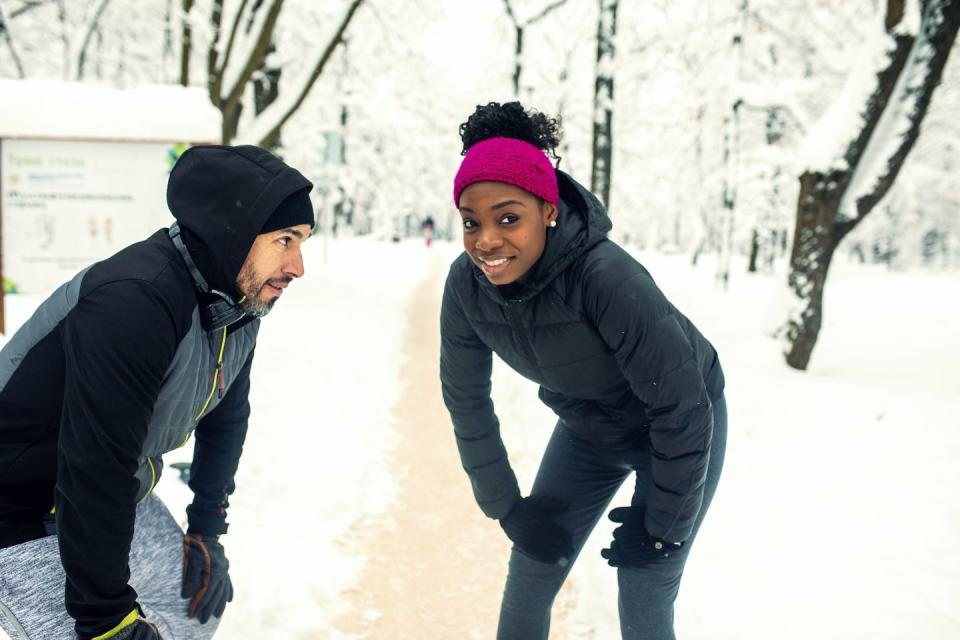Outdoor workout tips from the pros to beat the cold

If you're finding it tough to stick to a workout routine, or drag yourself outdoors for a spot of sweating and endorphins at the moment – you're not alone. These colder, darker days don't make it easy. But while using the weather as an excuse to skip your workout may be tempting, it turns out wintry conditions are actually *good* for you on the fitness front (sorry!).
So unless it's a 100mph blizzard, better start lacing those trainers up – and if you're looking for a bit of outdoor workout inspiration, motivation and ideas for routines, read on...
What are the benefits of outdoor workouts?
For starters, running in cool temperatures feels easier, keeps your heart rate lower and slows dehydration, according to research from St Mary’s University in London. Regardless of the time of year, outdoor training is generally found to be best for boosting mood too (one study found that when people exercised in nature, they had more energy and felt less tense and depressed compared to when they worked out indoors). Even better, is the fact you’re more likely to exercise for at least 30 minutes longer per week if you do it exclusively outside – and, let’s be honest, crushing a workout in savage weather feels far better than your average laptop-lead sweat-along.
Tips for outdoor workouts:
Get the right gear
Think less bulk, more layers. "You don’t need as much gear as you think you do," says Mark Andrew Sunderland, a specialist in performance apparel at Thomas Jefferson University. He recommends choosing multiple thin, wind-resistant pieces you can shed as you warm up, keeping your base layer on the bottom. You should also still feel a little chilly when you step out of the door.
Embrace the shiver
The shock you feel when you swap your duvet for the frosty pavement is (sadly) unavoidable, but that shiver up your spine serves a purpose – it signals that your metabolism is revving up. Your body is hard-wired to prefer storing fat over burning it, so it sends you a warning that you’re at risk of expending your stockpiled calories. That’s the point, so keep pushing on.

Warm up well
We all know how hard it is to leave a cosy bed, so this should be welcome news:
it’s OK to delay going outside for a little longer, as long as you’re spending those extra minutes getting ready to roll. By warming up inside and raising your heart rate, you’ll increase the blood flow to your muscles prior to going out in the freezing cold. Plus, you’ll be lubricating your lungs, getting them ready to work, and preparing your body for the undeniably bleak weather it’s about to encounter.
Try foam rolling, walking or jogging for a few minutes, then incorporating a movement-based exercise, like jumping jacks or mountain climbers (or even just running up and down the stairs – anything to get your blood flowing without breaking a sweat) for five minutes. When you do make it out of the door, give your body time to adjust to the conditions by taking 30-second breaks every few minutes for the first ten. Not so bad after all, eh?
Be flexible on timings
You may be an early-bird exerciser, but on extremely cold days, your best – and safest – bet is to hold off until mid-afternoon. This means you’re not going out in the dark and temperatures are at their highest. If you’re having to battle extreme winds, ice or darkness, then sit it out – safety first. “One way to do your recommended 150 minutes of weekly physical activity is to do 30 minutes’ exercise five days a week. But depending on your fitness, you may want to break this into chunks, build up to it over time, or go for a little longer,” says running coach and personal trainer Mollie Millington (known as PT Mollie). “If you’re worried about slipping on ice, even a brisk walk will do."
Buddy up
Pairing up in colder months can hold you accountable and keep you in a routine when it comes to regular exercise (especially on those days when vegging out in front of the TV with a mountain of spag bol feels far more appealing). “It’s also safer to be out in a group, especially when it’s dark or remote, or if there’s inclement weather,” says Elliott Upton, a personal trainer at Ultimate Performance. Plus, teaming up with someone who you perceive to be athletically superior can make you go longer and harder than if you were going at it alone (up to 200% harder, actually), according to a Kansas State University study.
Plan ahead
Stable, safe footing should be your priority when planning a winter running route. Look for a loop in your neighbourhood that you can repeat as many times as you want – that way, if you become tired, the ground turns slippy or you get wet, you'll still be close to home and can quickly escape the elements. If you’re running on a blustery day, try to run into the wind on your way out and have it at your back on your return.
It’s best to avoid running into the wind when you’re wet and sweaty because you’ll risk getting a chill. Alternatively, if running isn’t your bag, try something short and sharp like HIIT (high-intensity interval training), says Upton. “Ultimately, though, the best type of winter training is always going to be one that you enjoy and are therefore more likely to keep up.”
Wind down properly
Once you stop running, squatting or whatever it is you prefer doing, your core body temperature will drop quickly, so ditch those wet, sweaty clothes as soon as you can (sports bra and all). A warm shower (not hot, as your skin will be sensitive) will do nicely too, so make sure you leave time for one. “Warming back up gradually while stretching indoors will help your body recover from your session,” says Millington. A hot drink or hearty soup (which will also help to replenish your protein and sodium stores) is another sure-fire way to feel toasty again.

What's a good outdoor workout routine?
“Over a set period of 20 to 30 minutes, HIIT has a significantly higher calorie burn than running or steady-state cardio,” trainer Upton explains. “It’s the best way to keep your activity levels up when the shorter days and rubbish weather can reduce your daily movements – and, in turn, your energy expenditure – and can help stave off seasonal weight gain.” This type of training also increases your lactate threshold (simply defined as the upper limit of your efforts) and raises your metabolic rate. Try one of the following routines two to three times a week – any longer and your body won’t have enough recovery time.
Interval Running
For 20 seconds, sprint as fast as you can – leave nothing in the tank.
Then walk, breathe and recover fora minute– phew!
Repeat this for 10 rounds (it should take you under 15 minutes).
Each week, add an extra round to push yourself and expend more energy.
Circuits
Bodyweight circuits are another great way of working out quickly and effectively in the cold. Perform 10-15 reps of each, alternating between lower-body, upper-body and core-targeting moves. Choose six exercises (think: squats, push-ups, reverse lunges, planks, side planks and single-leg hip thrusts). When you’ve done all six, take a two-minute rest before repeating for four full rounds.
Cosmopolitan UK's current issue is out now and you can SUBSCRIBE HERE.
Like this article? Sign up to our newsletter to get more articles like this delivered straight to your inbox.
You Might Also Like

